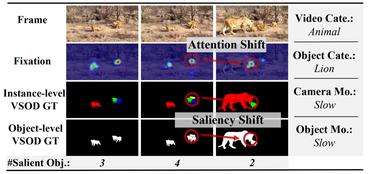Video Salient Object Detection
20 papers with code • 10 benchmarks • 4 datasets
Video salient object detection (VSOD) is significantly essential for understanding the underlying mechanism behind HVS during free-viewing in general and instrumental to a wide range of real-world applications, e.g., video segmentation, video captioning, video compression, autonomous driving, robotic interaction, weakly supervised attention. Besides its academic value and practical significance, VSOD presents great difficulties due to the challenges carried by video data (diverse motion patterns, occlusions, blur, large object deformations, etc.) and the inherent complexity of human visual attention behavior (i.e., selective attention allocation, attention shift) during dynamic scenes. Online benchmark: http://dpfan.net/davsod.
( Image credit: Shifting More Attention to Video Salient Object Detection, CVPR2019-Best Paper Finalist )
Latest papers
Depth Quality-Inspired Feature Manipulation for Efficient RGB-D and Video Salient Object Detection
Inspired by the fact that depth quality is a key factor influencing the accuracy, we propose an efficient depth quality-inspired feature manipulation (DQFM) process, which can dynamically filter depth features according to depth quality.
Motion-aware Memory Network for Fast Video Salient Object Detection
Moreover, inspired by the boundary supervision commonly used in image salient object detection (ISOD), we design a motion-aware loss for predicting object boundary motion and simultaneously perform multitask learning for VSOD and object motion prediction, which can further facilitate the model to extract spatiotemporal features accurately and maintain the object integrity.
Hierarchical Feature Alignment Network for Unsupervised Video Object Segmentation
Optical flow is an easily conceived and precious cue for advancing unsupervised video object segmentation (UVOS).
Learning Video Salient Object Detection Progressively from Unlabeled Videos
Recent deep learning-based video salient object detection (VSOD) has achieved some breakthrough, but these methods rely on expensive annotated videos with pixel-wise annotations, weak annotations, or part of the pixel-wise annotations.
A Unified Transformer Framework for Group-based Segmentation: Co-Segmentation, Co-Saliency Detection and Video Salient Object Detection
Besides, they fail to take full advantage of the cues among inter- and intra-feature within a group of images.
Depth-Cooperated Trimodal Network for Video Salient Object Detection
However, existing video salient object detection (VSOD) methods only utilize spatiotemporal information and seldom exploit depth information for detection.
Full-Duplex Strategy for Video Object Segmentation
Previous video object segmentation approaches mainly focus on using simplex solutions between appearance and motion, limiting feature collaboration efficiency among and across these two cues.
Video Salient Object Detection via Adaptive Local-Global Refinement
Despite their simplicity, such fusion strategies may introduce feature redundancy, and also fail to fully exploit the relationship between multi-level features extracted from both spatial and temporal domains.
Weakly Supervised Video Salient Object Detection
Significant performance improvement has been achieved for fully-supervised video salient object detection with the pixel-wise labeled training datasets, which are time-consuming and expensive to obtain.
Dynamic Context-Sensitive Filtering Network for Video Salient Object Detection
Our bidirectional dynamic fusion strategy encourages the interaction of spatial and temporal information in a dynamic manner.











 FBMS
FBMS
 SegTrack-v2
SegTrack-v2
 FBMS-59
FBMS-59
 ViSal
ViSal
